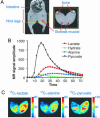Real-time metabolic imaging
- PMID: 16837573
- PMCID: PMC1544077
- DOI: 10.1073/pnas.0601319103
Real-time metabolic imaging
Abstract
The endogenous substance pyruvate is of major importance to maintain energy homeostasis in the cells and provides a window to several important metabolic processes essential to cell survival. Cell viability is therefore reflected in the metabolism of pyruvate. NMR spectroscopy has until now been the only noninvasive method to gain insight into the fate of pyruvate in the body, but the low NMR sensitivity even at high field strength has only allowed information about steady-state conditions. The medically relevant information about the distribution, localization, and metabolic rate of the substance during the first minute after the injection has not been obtainable. Use of a hyperpolarization technique has enabled 10-15% polarization of (13)C(1) in up to a 0.3 M pyruvate solution. i.v. injection of the solution into rats and pigs allows imaging of the distribution of pyruvate and mapping of its major metabolites lactate and alanine within a time frame of approximately 10 s. Real-time molecular imaging with MRI has become a reality.
Conflict of interest statement
Conflict of interest statement: K.G., R.i.t.Z., and M.T. are employees of Amersham Health R&D AB Malmö, which is now part of GE Healthcare.
Figures





References
-
- Månsson S., Johansson E., Magnusson P., Chai C. M., Hansson G., Petersson J. S., Stahlberg F., Golman K. Eur. Radiol. 2005;16:57–67. - PubMed
-
- Gadian D. G. NMR and Its Applications to Living Systems. Oxford: Oxford Univ. Press; 1995.
-
- de Graaf R. A. In Vivo NMR Spectroscopy: Principles and Techniques. London: Wiley; 1998.
MeSH terms
Substances
LinkOut - more resources
Full Text Sources
Other Literature Sources
Medical

